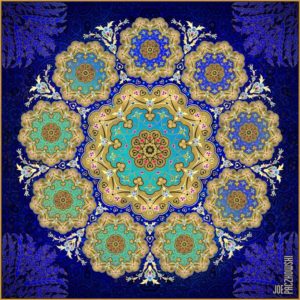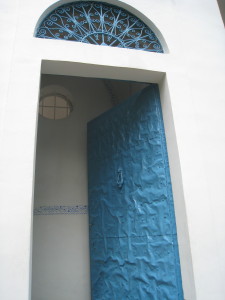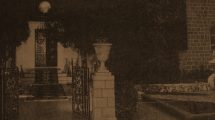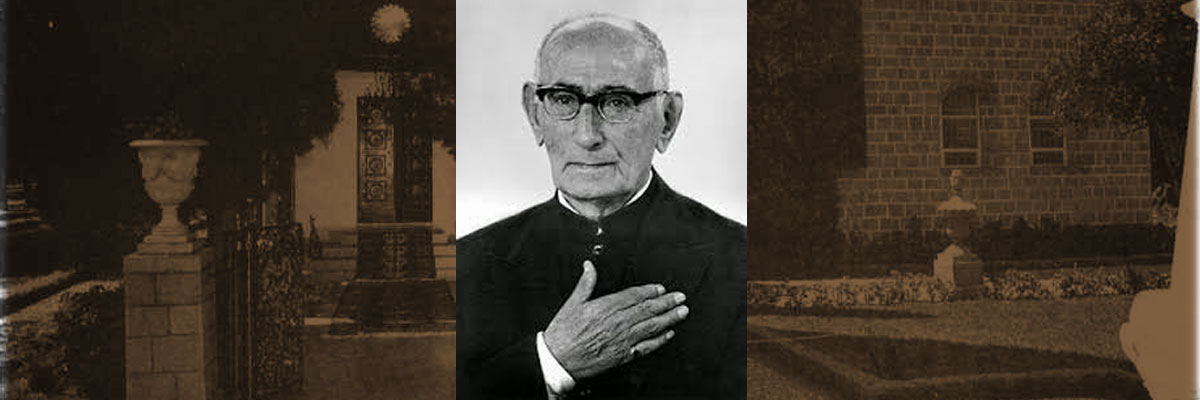 ‘Alavíyyih Khánum
‘Alavíyyih Khánum
Born: 1855
Death: 1918
Place of Birth: Máhfurúzak, Mazandaran, Iran
Location of Death: Máhfurúzak, Mazandaran, Iran
Burial Location: No Cemetery details
Mullá ‘Alí Ján
Born: 1846
Death: June 28, 1883
Place of Birth: Ríkandih, Mazandaran, Iran
Location of Death: Tehran, Iran
Burial Location: No Cemetery details
Hamídih, who became known as ‘Alavíyyih Khánum, was born in Máhfurúzak in the province of Mazandaran in northern Iran in about 1855. Her mother was named Khurshíd; her father, Áqá Mírzá Áqá Ján, was a distinguished resident of the village. Because Hamídih was a descendant of the Prophet Muhammad and of the Imam Ali, she was called ‘Alavíyyih, the feminine derivative of the name of the Prophet’s son-in-law, Ali.
Mullá ‘Alí Ján, the son of Áqá Ja‘far and Áminih Khánum, was born in the nearby village of Ríkandih in 1846. His parents died while he was young, and his uncle Áqá Mírzá Áqá Ján enabled Mullá ‘Alí Ján to complete his education as a mullá in the towns of Sárí and Barfurush (now Babul). Mullá ‘Alí Ján then spent a year in the village of Surkhrúd before his uncle summoned him to Máhfurúzak to become the religious leader of the village (píshnamáz, prayer leader, and rawdih-khán, reciter of traditional lamentations for the imams, especially the martyred Husayn). About three years later, Áqá Mírzá Áqá Ján died. His final wish was that his daughter, ‘Alavíyyih Khánum, wed Mullá ‘Alí Ján. The cousins were married in 1871, when ‘Alavíyyih Khánum was sixteen.
Bahá’í Activities 1883:
While studying in Barfurush, Mullá ‘Alí Ján had been introduced to the Bahá’í Faith by Ustád Muhammad Kuláh-dúz and had been convinced of the truth of the new religion by Áqá Siyyid Muhammád Ridá Shahmírzádí, a traveling Bahá’í teacher. For Mullá ‘Alí Ján’s first three years as religious leader of Máhfurúzak, during which he gained the love and respect of the entire village, he did not reveal his new faith to anyone. Shortly after his uncle’s death, however, Mullá ‘Alí Ján began to talk about his beliefs with his wife and other members of his uncle’s family, all of whom became Bahá’ís. He also began to teach the Bahá’í Faith openly from the pulpit. His efforts were enhanced by the high regard in which the villagers held him, and a majority of the inhabitants of Máhfurúzak soon became Bahá’ís. His travels to surrounding villages led to similar results; he brought many people in the environs of Máhfurúzak into the Ba há’í Faith.
há’í Faith.
Mullá ‘Alí Ján and ‘Alavíyyih Khánum, not content with the conversion of the inhabitants of Máhfurúzak to the Bahá’í Faith, started to organize the life of the village on a spiritual basis. They encouraged each family to set aside a special room for prayer. There, wearing clean attire rather than work clothes, the family members would pray daily in the morning and evening. Mullá ‘Alí Ján and ‘Alavíyyih Khánum established two schools, one for girls and the other for boys, enabling all the children of the village to receive an elementary education. These appear to have been the first Bahá’í schools established in the country. In addition, the couple organized classes where villagers were able to discuss religious matters.
Mullá ‘Alí Ján and ‘Alavíyyih Khánum also made efforts to improve the economic basis of the village. They initiated a buying and selling cooperative, through which Máhfurúzak’s farmers could obtain better prices for their fruit and rice, and arranged for residents to learn crafts so that they could make some of the necessities of life. The couple also developed a new source of income for the village: the buying of cotton to be cleaned, carded, and sold to Russian and Armenian merchants for export to Russia.
News of the changes taking place in Máhfurúzak began to reach the ulama (Muslim religious leaders) in Sárí. Presumably, they saw the developments in the village as challenges to the existing order in rural Iran and to their own authority, for they reported to the provincial governor that the inhabitants of Máhfurúzak were planning an insurrection. When the information was conveyed to the central government, investigators were dispatched to the village, but they found nothing amiss. The ulama did not relent, however, and continued sending their allegations to the shah. Eventually, the government acceded and ordered Mullá ‘Alí Jan’s arrest.
At dawn on April 29, 1883, some four hundred horsemen raided the village of Máhfurúzak, looted many houses, and arrested Mullá ‘Alí Ján, three of his brothers-in-law, and four others, taking them to Sárí. Later the same day, another fifty horsemen swept into the village. They apprehended ‘Alavíyyih Khánum, five other women, and two men and confiscated all of ‘Alavíyyih Khánum’s and Mullá ‘Alí Ján’s books and possessions. The couple’s six-year-old daughter, Baqá’íyyih, would not be separated from ‘Alavíyyih Khánum and was taken away with the prisoners, all of whom were detained for a time before being released.
A large armed escort took Mullá ‘Alí Ján and the seven arrested with him to Tehran. His companions were thrown into a dungeon, where they remained for two years, but Mullá ‘Alí Ján was singled out for execution. He was killed in the city’s public execution square on June 28, 1883, after which his body was put on display for three days until two Bahá’í women, at great risk to themselves, managed to remove the remains for burial. Bahá’u’lláh honored Mullá ‘Alí Ján’s life and martyrdom with a “tablet of visitation” (a prayer, often in the form of a eulogy, to be read when visiting the grave site of an eminent person).
‘Alavíyyih Khánum in Widowhood:
‘Alavíyyih Khánum was twenty-eight years old when her husband was executed. Three years later, her two children became ill and died as well. Having lost her husband and children, ‘Alavíyyih Khánum devoted the rest of her life entirely to the Bahá’í Faith. She continued the reforms that she and her husband had started in the village, concentrating especially on the education of children, both girls and boys. Her efforts caused her to become the most prominent Bahá’í in Máhfurúzak.
‘Alavíyyih Khánum also began to travel as a teacher of the Bahá’í Faith. At first, in the years following the death of her children, she visited nearby villages in Mazanderan, such as ‘Arabkhayl and Bihnamír, as well as towns such as Barfurush, ‘Aliyábád, and Sárí. She spoke persuasively and brought many people into the Bahá’í Faith.
Later, at ‘Abdu’l-Bahá’s request, she began to travel more extensively. In 1901, she undertook a major trip to the Iranian province of Khurasan and then to Ashgabat in Russian Turkmenistan and beyond. After this trip she visited ‘Abdu’l-Bahá in Palestine.
Early in 1903, while in Mashhad, she received a letter from ‘Abdu’l-Bahá instructing her to proceed to the city of Yazd together with her nephew and Mírzá Husayn Zanjání, a devout Bahá’í teacher who had been imprisoned with the noted martyrs Mírzá ‘Alí Muhammad Varqá and his twelve-year-old son, Rúhu’lláh, in Tehran in 1896 and who is remembered for his account of their last days. While ‘Alavíyyih Khánum and her companions were traveling as part of a caravan, an upheaval began in Yazd. The city’s new imám-jum‘ih (leader of Friday prayers), spurred by the Mujtahid of Isfahan, Shaykh Muhammad Taqí (known to Bahá’ís as the Son of the Wolf), preached in the mosque against the Bahá’ís, unleashing an outbreak of violent persecution in June and July 1903 that resulted in the death of scores of Bahá’í men, women, and children. When news of the events in Yazd reached the caravan, their fellow travelers turned against ‘Alavíyyih Khánum and her party and began abusing them. By the time they arrived in Yazd, a crowd had gathered to attack them, but government authorities dispersed it.
From Yazd, ‘Alavíyyih Khánum went to Ábádih, a small town in the province of Fárs. She remained there for a few months before returning to Máhfurúzak by way of Tehran.
In her later years, ‘Alavíyyih Khánum became blind and was unable to leave Máhfurúzak. Before she died in about 1918, she donated her house as a Bahá’í center and place of worship (See: Mashriqu’l-Adhkár). ‘Abdu’l-Bahá honored her by giving her the title Amatu’l-Bahá (Maidservant of Bahá) and by writing a tablet of visitation for her.
Source:
Mottahedin-Mavaddat, Mehraeen and Momen, “Alavíyyih Khánum and ‘Alí Ján, Mullá” Bahá’í Encyclopedia Project, bahai-encyclopedia-project.org
Images:
Art Design by Joe Paczkowski
(c) Baha’i Chronicles




